Ford Escape: Front Seats
![]() WARNING: Reclining the seatback can cause an occupant to
slide under the seat’s safety belt, resulting in severe personal
injuries in the event of a collision.
WARNING: Reclining the seatback can cause an occupant to
slide under the seat’s safety belt, resulting in severe personal
injuries in the event of a collision.
![]() WARNING: Do not pile cargo higher than the seatbacks to
reduce the risk of injury in a collision or sudden stop.
WARNING: Do not pile cargo higher than the seatbacks to
reduce the risk of injury in a collision or sudden stop.
![]() WARNING: Before returning the seatback to its original
position, make sure that cargo or any objects are not trapped
behind the seatback. After returning the seatback to its original
position, pull on the seatback to ensure that it has fully latched. An
unlatched seat may become dangerous in the event of a sudden stop or
collision.
WARNING: Before returning the seatback to its original
position, make sure that cargo or any objects are not trapped
behind the seatback. After returning the seatback to its original
position, pull on the seatback to ensure that it has fully latched. An
unlatched seat may become dangerous in the event of a sudden stop or
collision.
Adjustable head restraints
Your vehicle is equipped with front row outboard head restraints that are vertically adjustable.
![]() WARNING: To minimize the risk of neck injury in the event of a
crash, the driver and passenger occupants should not sit in
and/or operate the vehicle, until the head restraint is placed in its
proper position. The driver should never adjust the head restraint
while the vehicle is in motion.
WARNING: To minimize the risk of neck injury in the event of a
crash, the driver and passenger occupants should not sit in
and/or operate the vehicle, until the head restraint is placed in its
proper position. The driver should never adjust the head restraint
while the vehicle is in motion.
The adjustable head restraints consist of:
• a trimmed energy absorbing foam
and structure (1),
• two steel stems (2),
• a guide sleeve adjust/release
button (3),
• and a guide sleeve unlock/remove
button (4).

To adjust the head restraint, do the following:
1. Adjust the seatback to an upright driving/riding position.
2. Raise the head restraint by
pulling up on the head restraint.
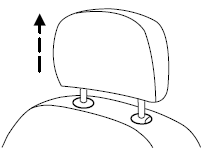
3. Lower the head restraint by pressing and holding the guide sleeve adjust/release button and pushing down on the head restraint.
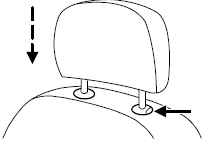
Properly adjust the head restraint so that the top of the head restraint is even with the top of your head and positioned as close as possible to the back of your head. For occupants of extremely tall stature, adjust the head restraint to its full up position.
![]() WARNING: The adjustable head restraint is a safety device.
WARNING: The adjustable head restraint is a safety device.
Whenever possible it should be installed and properly adjusted when the seat is occupied.
To remove the adjustable head restraint, do the following:
1. Pull up the head restraint until it reaches the highest adjustment position.

2. Simultaneously press and hold both the adjust/release button and the unlock/remove button, then pull up on the head restraint.
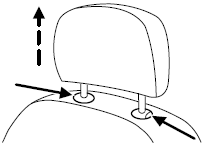
To reinstall the adjustable head restraint, do the following:
1. Insert the two stems into the
guide sleeve collars.
2. Push the head restraint down
until it locks.
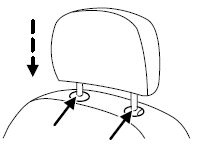
Properly adjust the head restraint so that the top of the head restraint is even with the top of your head and positioned as close as possible to the back of your head. For occupants of extremely tall stature, adjust the head restraint to its full up position.
![]() WARNING: To minimize the risk of neck injury in the event of a
crash, head restraints must be installed properly.
WARNING: To minimize the risk of neck injury in the event of a
crash, head restraints must be installed properly.
Adjusting the front manual seat (if equipped)
Lift handle to move seat forward or backward.

Pull lever up to adjust seatback.
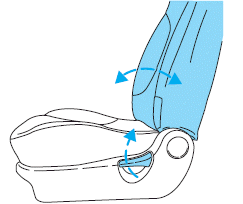
Using the manual lumbar support (if equipped)
The lumbar support control is located on the inboard side of the driver’s seatback.
Turn the lumbar support control clockwise to increase firmness.
Turn the lumbar support control counterclockwise to increase softness.

Adjusting the front power seat (if equipped)
![]() WARNING: Never adjust the driver’s seat or seatback when the
vehicle is moving.
WARNING: Never adjust the driver’s seat or seatback when the
vehicle is moving.
![]() WARNING: Do not pile cargo higher than the seatbacks to avoid
injuring people in a collision or sudden stop.
WARNING: Do not pile cargo higher than the seatbacks to avoid
injuring people in a collision or sudden stop.
![]() WARNING: Always drive and ride with your seatback upright
and the lap belt snug and low across the hips.
WARNING: Always drive and ride with your seatback upright
and the lap belt snug and low across the hips.
![]() WARNING: Reclining the seatback can cause an occupant to
slide under the seat’s safety belt, resulting in severe personal
injuries in the event of a collision.
WARNING: Reclining the seatback can cause an occupant to
slide under the seat’s safety belt, resulting in severe personal
injuries in the event of a collision.
![]() WARNING: Sitting improperly out of position or with the seat
back reclined too far can take off weight from the seat cushion
and affect the decision of the passenger sensing system, resulting in
serious injury or death in a crash. Always sit upright against your
seatback, with your feet on the floor.
WARNING: Sitting improperly out of position or with the seat
back reclined too far can take off weight from the seat cushion
and affect the decision of the passenger sensing system, resulting in
serious injury or death in a crash. Always sit upright against your
seatback, with your feet on the floor.
![]() WARNING: To reduce the risk of possible serious injury: Do not
hang objects off seat back or stow objects in the seatback map
pocket (if equipped) when a child is in the front passenger seat. Do
not place objects underneath the front passenger seat or between the
seat and the center console (if equipped). Check the “passenger airbag
off” or “pass airbag off” indicator lamp for proper airbag status. Refer
to Front passenger sensing system in the Airbag supplemental
restraint system (SRS) section for additional details. Failure to follow
these instructions may interfere with the front passenger seat sensing
system.
WARNING: To reduce the risk of possible serious injury: Do not
hang objects off seat back or stow objects in the seatback map
pocket (if equipped) when a child is in the front passenger seat. Do
not place objects underneath the front passenger seat or between the
seat and the center console (if equipped). Check the “passenger airbag
off” or “pass airbag off” indicator lamp for proper airbag status. Refer
to Front passenger sensing system in the Airbag supplemental
restraint system (SRS) section for additional details. Failure to follow
these instructions may interfere with the front passenger seat sensing
system.
The control is located on the outboard side of the seat cushion.
Press to raise or lower the front portion of the seat cushion.

Press to raise or lower the rear portion of the seat cushion.

Press the control to move the seat forward, backward, up or down.

Heated seats (if equipped)
![]() WARNING: Persons who are unable to feel pain to the skin
because of advanced age, chronic illness, diabetes, spinal cord
injury, medication, alcohol use, exhaustion, or other physical
conditions, must exercise care when using the seat heater. The seat
heater may cause burns even at low temperatures, especially if used
for long periods of time. Do not place anything on the seat that
insulates against heat, such as a blanket or cushion, because this may
cause the seat heater to overheat. Do not puncture the seat with pins,
needles, or other pointed objects because this may damage the heating
element which may cause the seat heater to overheat. An overheated
seat may cause serious personal injury.
WARNING: Persons who are unable to feel pain to the skin
because of advanced age, chronic illness, diabetes, spinal cord
injury, medication, alcohol use, exhaustion, or other physical
conditions, must exercise care when using the seat heater. The seat
heater may cause burns even at low temperatures, especially if used
for long periods of time. Do not place anything on the seat that
insulates against heat, such as a blanket or cushion, because this may
cause the seat heater to overheat. Do not puncture the seat with pins,
needles, or other pointed objects because this may damage the heating
element which may cause the seat heater to overheat. An overheated
seat may cause serious personal injury.
Note: Do not do the following:
• Place heavy objects on the seat
• Operate the seat heater if water or any other liquid is spilled on the
seat. Allow the seat to dry thoroughly.
To operate the heated seats:
• Press the button located on the
instrument panel to activate.
• Press again to deactivate.

The heated seats will activate when the ignition is in the on position and the engine is running.
See also:
SRS airbag (Supplemental Restraint System airbag)
*SRS: This stands for supplemental restraint
system. This name is used because
the airbag system supplements the
vehicle’s seatbelts.
Your vehicle is equipped with a crash
sensing and diagnostic module, which will
record the use of the s ...
Third seat (7 persons)
To fold out the underfloor-stowable third seat
The third seat is stowed under the floor. Use the seat when extra people ride
in your vehicle. When not in use, stow the seat under the floor and use as a luggage
area.
WARNING:
● Make sure ...

 Securilock passive anti-theft system
Securilock passive anti-theft system